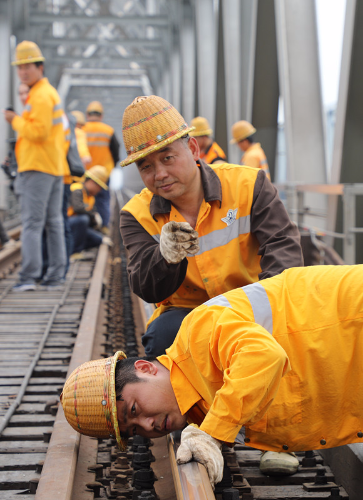Railway workers keep trains on a smooth path
By QI XIN/YANG ZEKUN | China Daily | Updated: 2018-08-09 07:09

Maintaining the tracks requires being outside in all temperatures
Editor's note: As hot weather lingers in southern China this week, China Daily reporters tell stories of people from various lines of work who cannot retreat to cooler indoor spaces. They work under the sun to help others.
For railway maintenance workers, summer means more responsibility.
The hotter the weather, the more likely the tracks are to expand and become warped, which might lead to derailments if the problems are not fixed in time, said Dong Weiguo, who works for the Zhengzhou Railway Administration's Xinxiang bridge section.
He is on one of the teams of workers sent out to detect problems.
"The patrol can't be done only when the weather is cooler, such as at night. It must be done when there is no train passing," he said.
The railway bridge his unit cares for is part of a railway linking Xinxiang, Henan province, and Heze, Shandong province. Nearly 90 pairs of trains laden with coal zip back and forth every day. About 100 million metric tons of coal for generating electricity are transported via the line each year.
Sometimes workers have to go out at noon, no matter how high the temperature soars.
A yellow alert for continuing high temperatures was issued for Henan province recently, and the steel tracks on the bridge heated up to 50 C. Dong said the workers' clothes become soaked in sweat in just a few minutes.
Zhang Xinchao, 50, who has worked for more than 20 years in the sector, said he usually spends five to six hours working under the sun.
"We all have to wear long-sleeved, thick work clothes to avoid sunburn. If we wear anything thin, our skin will be red after working all day in the summer heat," he said.
In such high temperatures, they look for changes in the shape of the tracks-even just a few millimeters of warping.
If the track deviation is not serious, workers will pour water on the rails to cool them, and then keep watch.
If track expansion continues beyond an acceptable range, they will block the line to fix the problem, according to Dong.
"By hammering on each wooden railroad tie, workers can tell how much it has eroded and when to replace them with new ones," Dong said, adding a routine check of the ties is arranged once a month.
Yang Zekun contributed to this story.
























